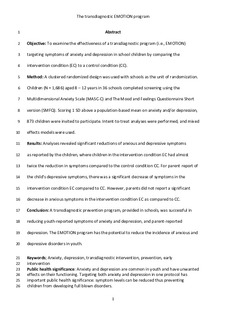| dc.contributor.author | Martinsen, Kristin Dagmar | |
| dc.contributor.author | Rasmussen, Lene-Mari Potulski | |
| dc.contributor.author | Wentzel-Larsen, Tore | |
| dc.contributor.author | Holen, Solveig | |
| dc.contributor.author | Sund, Anne Mari | |
| dc.contributor.author | Løvaas, Mona Elisabeth S | |
| dc.contributor.author | Patras, Joshua | |
| dc.contributor.author | Kendall, Philip C | |
| dc.contributor.author | Waaktaar, Trine | |
| dc.contributor.author | Neumer, Simon-Peter | |
| dc.date.accessioned | 2019-02-15T09:25:33Z | |
| dc.date.available | 2019-02-15T09:25:33Z | |
| dc.date.created | 2018-09-28T10:58:23Z | |
| dc.date.issued | 2018 | |
| dc.identifier.citation | Journal of Consulting and Clinical Psychology. 2018, 8 (2), 212-219. | nb_NO |
| dc.identifier.issn | 0022-006X | |
| dc.identifier.uri | http://hdl.handle.net/11250/2585635 | |
| dc.description.abstract | Objective: The objective of the study was to examine the effectiveness of a transdiagnostic program (EMOTION, Coping Kids Managing Anxiety and Depression) targeting symptoms of anxiety and depression in schoolchildren by comparing the intervention condition (EC) to a control condition (CC). Method: A clustered randomized design was used with schools as the unit of randomization. Children (N = 1686) aged 8–12 years in 36 schools completed screening using the Multidimensional Anxiety Scale (MASC-Child) and The Mood and Feelings Questionnaire Short version (SMFQ-Child). Scoring 1 SD above a population-based mean on anxiety and/or depression, 873 children were invited to participate. Intent-to-treat analyses were performed, and mixed-effects models were used. Results: Analyses revealed significant reductions of anxious and depressive symptoms as reported by the children, in which children in the intervention condition EC had almost twice the reduction in symptoms compared with the control condition CC. For parent report of the child’s depressive symptoms, there was a significant decrease of symptoms in the intervention condition EC compared with CC. However, parents did not report a significant decrease in anxious symptoms in the intervention condition EC as compared with CC. Conclusion: A transdiagnostic prevention program, provided in schools, was successful in reducing youth-reported symptoms of anxiety and depression and parent-reported depression. The EMOTION program has the potential to reduce the incidence of anxious and depressive disorders in youth. | nb_NO |
| dc.language.iso | eng | nb_NO |
| dc.publisher | American Psychological Association | nb_NO |
| dc.title | Prevention of anxiety and depression in school children: Effectiveness of the transdiagnostic EMOTION program | nb_NO |
| dc.type | Journal article | nb_NO |
| dc.type | Peer reviewed | nb_NO |
| dc.description.version | acceptedVersion | nb_NO |
| dc.source.pagenumber | 212-219 | nb_NO |
| dc.source.volume | 8 | nb_NO |
| dc.source.journal | Journal of Consulting and Clinical Psychology | nb_NO |
| dc.source.issue | 2 | nb_NO |
| dc.identifier.doi | 10.1037/ccp0000360 | |
| dc.identifier.cristin | 1615558 | |
| dc.relation.project | Norges forskningsråd: 228846 | nb_NO |
| dc.description.localcode | © 2018. This is the authors' accepted and refereed manuscript to the article. The final authenticated version is available online at: http://dx.doi.org/10.1037/ccp0000360 | nb_NO |
| cristin.unitcode | 194,65,35,5 | |
| cristin.unitcode | 194,67,40,0 | |
| cristin.unitname | RKBU Midt-Norge - Regionalt kunnskapssenter for barn og unge - psykisk helse og barnevern | |
| cristin.unitname | Institutt for psykologi | |
| cristin.ispublished | false | |
| cristin.fulltext | postprint | |
| cristin.qualitycode | 2 | |
